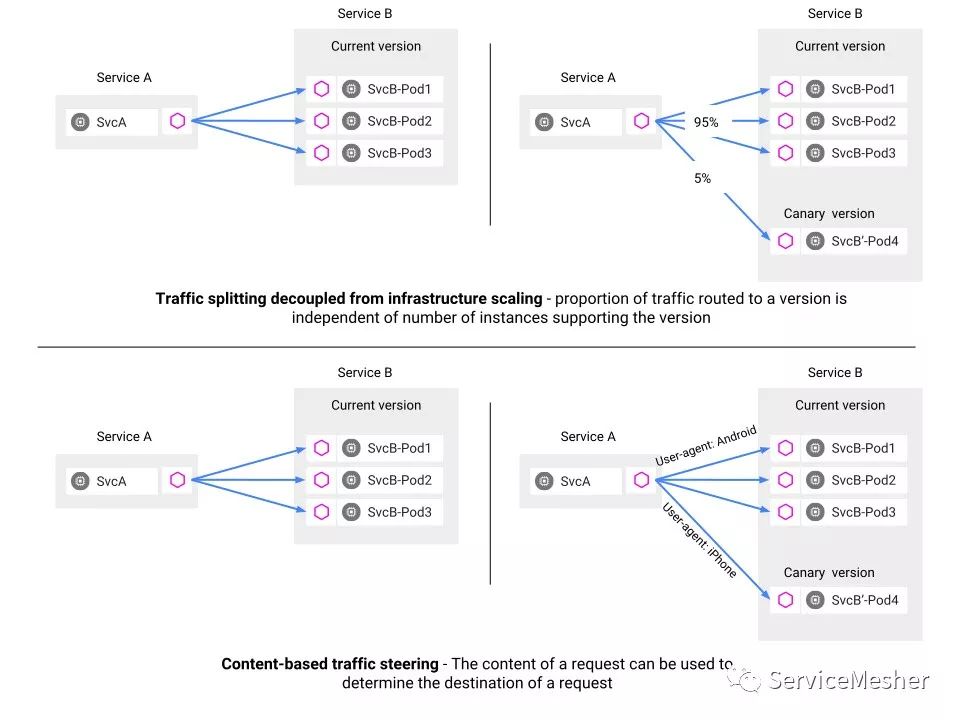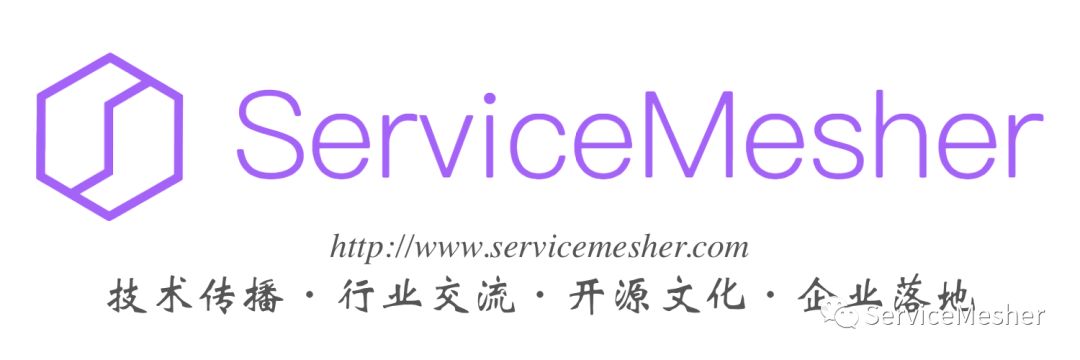使用Go语言操作Istio和其他Kubernetes CRD
Posted ServiceMesher
tags:
篇首语:本文由小常识网(cha138.com)小编为大家整理,主要介绍了使用Go语言操作Istio和其他Kubernetes CRD相关的知识,希望对你有一定的参考价值。
在本文中,我将演示如何使用Golang来操作Kubernetes Custom Resources,以Istio为例。 不需要您了解Istio,我只是用它来展示概念!
Istio是一个非常受欢迎的服务网格平台,它允许工程师快速地为基于服务的应用程序添加遥测技术、先进的流量管理等功能。
Istio工作原理的一个有趣的地方是,当部署到Kubernetes集群中时,许多关键配置对象被作为自定义资源处理。自定义资源是一个非常强大的Kubernetes特性,它允许您创建自己的”一等“资源(就像pod、副本、部署等),然后使用 kubectl或Kubernetes API与它们进行交互。
在本文中,我将展示如何使用Golang Kubernetes client与这些自定义资源交互。
CRD:快速概述
在为集群设置Istio时,您可能要做的一件常见的事情是指定如何路由通信。这可能相当复杂,如下所示:

图1:来自istio.io的Istio流量管理示例
对于这样的系统,有一种配置方法就是使用一个ConfigMap,其中包含如何路由服务的定义。
然而,Istio实际上注册了新的资源类型(自定义资源定义),来表示网关或服务之类的对象。我们可以创建/更新/删除/操作这些资源类型,就像任何其他Kubernetes对象一样。
例如,我可以为上面的示例创建一个虚拟服务,如下所示:
cat << EOF | kubectl create -f -
apiVersion: networking.istio.io/v1alpha3
kind: VirtualService
metadata:
name: service2
spec:
hosts:
- "*"
gateways:
- demo1-gateway
http:
- route:
- destination:
host: service2
subset: v1
weight: 95
- destination:
host: service2
subset: v2
weight: 5
EOF
同样,重要的不是这个资源的具体内容,而是我可以像对待其他Kubernetes对象一样对待Istio资源:
$ kubectl get virtualservices.networking.istio.io
NAME AGE
service2 93s
或者:
$ kubectl delete virtualservices.networking.istio.io/service2
甚至还可以使用 edit、 describe、注册生命周期事件、监视更改等等操作。
使用go语言操作CRD
使用Golang Kubernetes Client可以创建强定义的类型,然后就可以使用这些类型与CRD交互。红帽博客文章Kubernetes Deep Dive: Code Generation for Custom Resources就是一个例子。
这是一种非常好的方法,但是如果您想快速访问一些数据,而又不想生成大量代码,那么这种方法会让您感到非常吃力。
还有一种替代方法,即使用 DynamicClient。首选的方法似乎是第一种方法,它涉及到代码生成,因此第二种方法的文档很少。然而,第二种方法其实很简单。
下面这个例子介绍如何列出所有Istio VirtualService资源,而无需生成任何代码:
import (
metav1 "k8s.io/apimachinery/pkg/apis/meta/v1"
"k8s.io/client-go/dynamic"
)
// Create a Dynamic Client to interface with CRDs.
dynamicClient, _ := dynamic.NewForConfig(config)
// Create a GVR which represents an Istio Virtual Service.
virtualServiceGVR := schema.GroupVersionResource{
Group: "networking.istio.io",
Version: "v1alpha3",
Resource: "virtualservices",
}
// List all of the Virtual Services.
virtualServices, _ := dynamicClient.Resource(virtualServiceGVR).Namespace("default").List(metav1.ListOptions{})
for _, virtualService := range virtualServices.Items {
fmt.Printf("VirtualService: %s ", virtualService.GetName())
}
为了清晰起见,这段代码省略了设置和错误处理,完整的示例在k8s-list-virtualservices.go。
使用go语言修改CRD
您可能已经注意到,代码 .Resource().Namespace().List()与Kubernetes Clientset进行API调用时使用的结构非常相似。实际上,本质上是一样的。看看接口,你可以看到所有你想要的操作:
CreateUpdateDeleteGet
等等。这很好,因为您可以像我的文章'Patching Kubernetes Resources in Golang'中那样使用相同的技巧来操作这些实体,而无需创建表示它们的结构。
下面是另一个简短的例子,这次展示了如何将服务的路由的权重调整到50%/50%:
import (
metav1 "k8s.io/apimachinery/pkg/apis/meta/v1"
"k8s.io/client-go/dynamic"
)
// Create a GVR which represents an Istio Virtual Service.
virtualServiceGVR := schema.GroupVersionResource{
Group: "networking.istio.io",
Version: "v1alpha3",
Resource: "virtualservices",
}
// Weight the two routes - 50/50.
patchPayload := make([]PatchUInt32Value, 2)
patchPayload[0].Op = "replace"
patchPayload[0].Path = "/spec/http/0/route/0/weight"
patchPayload[0].Value = 50
patchPayload[1].Op = "replace"
patchPayload[1].Path = "/spec/http/0/route/1/weight"
patchPayload[1].Value = 50
patchBytes, _ := json.Marshal(patchPayload)
// Apply the patch to the 'service2' service.
_, err := dynamicClient.Resource(virtualServiceGVR).Namespace("default").Patch("service2", types.JSONPatchType, patchBytes)
请参阅 k8s-patch-virtualservice.go中的完整示例。
运行示例后,您可以使用Kubernetes CLI来验证更改:
$ kubectl get virtualservices.networking.istio.io/service2 -o yaml
apiVersion: networking.istio.io/v1alpha3
kind: VirtualService
metadata:
clusterName: ""
creationTimestamp: 2018-10-08T09:53:16Z
generation: 0
name: service2
namespace: default
resourceVersion: "487435"
selfLink: /apis/networking.istio.io/v1alpha3/namespaces/default/virtualservices/service2
uid: fac5930c-cadf-11e8-90a2-42010a94005b
spec:
gateways:
- demo1-gateway
hosts:
- '*'
http:
- route:
- destination:
host: service2
subset: v1
weight: 50
- destination:
host: service2
subset: v2
weight: 50
保持简单!
就是这样!这个技巧使我正在做的事情变得简单了很多,但是需要做一些实验才能得到正确的结果。我希望你觉得这个方法有用,请在评论中分享你的想法与问题。
进一步阅读
在采用这种方法时使用了以下几篇文章:
Red Hat: Deep Dive: Code Generation for Custom Resources
Kubernetes Docs: Custom Resources
点击【阅读原文】跳转到ServiceMesher网站上浏览可以查看文中的链接。
相关阅读

SOFAMesh(https://github.com/alipay/sofa-mesh)基于Istio的大规模服务网格解决方案
SOFAMosn(https://github.com/alipay/sofa-mosn)使用Go语言开发的高性能Sidecar代理
合作社区
参与社区
以下是参与ServiceMesher社区的方式,最简单的方式是联系我!
社区网址:http://www.servicemesher.com
Slack:https://servicemesher.slack.com (需要邀请才能加入)
GitHub:https://github.com/servicemesher
Istio中文文档进度追踪:https://github.com/servicemesher/istio-official-translation
Twitter: https://twitter.com/servicemesher
提供文章线索与投稿:https://github.com/servicemesher/trans
以上是关于使用Go语言操作Istio和其他Kubernetes CRD的主要内容,如果未能解决你的问题,请参考以下文章